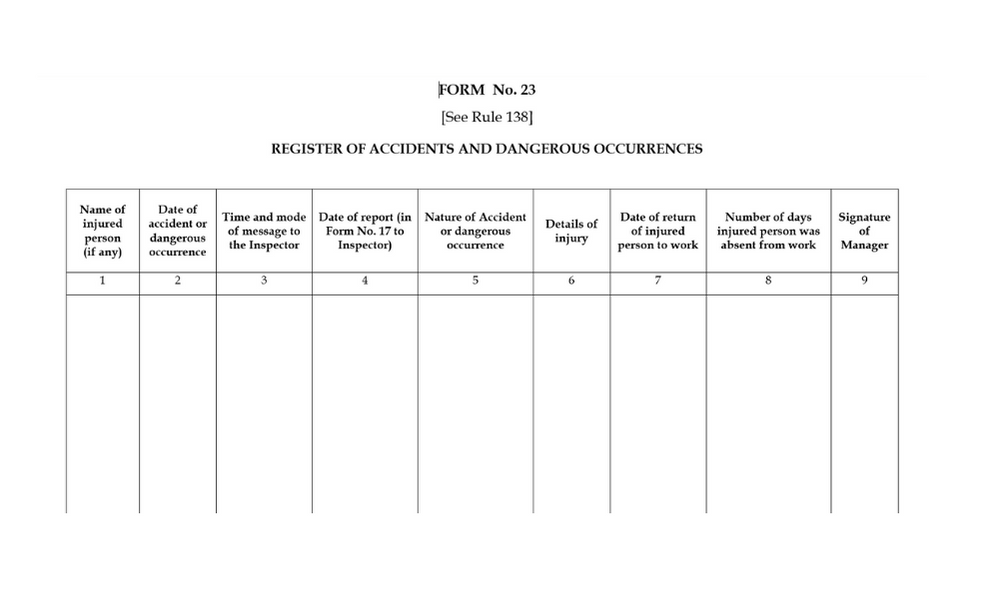Occupational safety is of prime importance irrespective of the sector. As a rapidly-developing nation, India has strict laws and regulations to ensure the well-being of the labour force.
Employers need to reinforce the concept of safety and maintain high standards to prevent any mishap at the workplace. However, there are instances when incidents do occur. In such cases, which lead to dire outcomes the manager or the owner of the factory is required to report the incident to the nearby authorities at the earliest.

Things to Know Before We Begin
- The 44 Labour Laws have now been consolidated into 4 primary Codes (discussed in the following section)
- OSHWC or the Occupational Safety, Health & Working Conditions Code is the code that is an amalgamation of many Labour laws which includes the Factories Act, 1948
- The Factories Act, 1948 has numerous statutory returns that must be filed, of which Karnataka Form 23 is a register that comprises information about accidents and dangerous occurrences
In the context of this, we will understand the significance of Karnataka Form 23- register of Accident or Dangerous Occurrence. The managers of the factories must utilize this form to record and report any such unfortunate event.
Here is the list of elements that we shall come across in this post:
- Brief Introduction of the 4 Labour Codes
- Labour Laws in India for Occupational Health and Safety
- Highlights of the Factories Act, 1948
- Applicability of the Act
- What is Karnataka Form 23- Register of Accident or Dangerous Occurrence?
- Karnataka Form 23- Register of Accident or Dangerous Occurrence
- What is a Dangerous Occurrence under Factories Act?
- Why Should Dangerous Occurrence be Reported?
- What is a reportable accident as per the Factory Act?
- Health and Safety Facilities for Workers
- Statutory returns that must be filed under the factories act with due dates
Brief Introduction of the 4 Labour Codes
There are 44 laws on labour grouped into 4 categories or codes:
- Wage Code
Wages and bonuses are regulated by the Code on Wages, 2019 which applies to all employees, including those in organized and unorganized sectors. The code also ensures equal pay for workers in all industries, trades, businesses, and manufacturers.
2. Social Security Code
Nine laws concerning social security and maternity benefits are consolidated in the Code on Social Security, 2020
3. Occupational Safety, Health & Working Conditions Code (OSHWC)
In all mines and docks, and establishments with more than 10 workers, the Code on Occupational Safety, Health, and Working Conditions, 2020 regulates workplace health and safety in establishments with 10 or more employees, as well as in mines and docks.
4. Industrial Relations Code
The Code on Industrial Relations, 2020 merges three labour laws: The Industrial Disputes Act, 1947: The Trade Unions Act, 1926 and The Industrial Employment (Standing Order) Act, 1946. As a result of the Code, businesses can reap several benefits, including a lowered labour compliance burden.
There has already been parliamentary approval of all four codes as well as the approval of the President.
Labour Laws in India for Occupational Health and Safety
Ministry of State for Labour and Employment introduced the Occupational Safety, Health and Working Conditions Code, 2020 (OSHWC) in Lok Sabha. There are 633 provisions of 13 major labour laws incorporated into one code with 143 provisions.
One of the laws it encompasses is the Factories Act, 1948, which in turn includes Form 23 of Accident or Dangerous Occurrence.
Highlights of the Factories Act, 1948
Factories Act, 1948, or the legislation for labour welfare was enacted with the primary purpose of safeguarding factory workers from occupational and industrial hazards.
A set of rules has been formulated by the State of Karnataka based on the provisions of the Act and are known as the Karnataka Factories Rules, 1969.
Accordingly, the Central Legislature has the authority to enact this Act. In certain sections of this Act, state governments/union territory administrations hold the power and authority to implement the Act's objectives.
Under Chapter III - Factories Act, 1948, Sections 21 to 41 outline the safety provisions for factory workers. Workers in factories are provided with a safe working environment through these provisions. This act incorporates provisions to ensure worker safety from accidents and dangerous occupations. The Act conveys safety as the first and most essential requirement.
The names of the sections that consist of the provisions are as follows:
- section 21: fencing of machinery
- section 22: work near or on the machinery in motion
- section 23: employment of young people on dangerous machines
- section 24: striking gear and devices for cutting the power off
- section 25: self-acting machines
- section 26: the casing of new machines
- section 27: Prohibiting employment of women and children near the cotton opener
- section 28: hoists and lifts
- section 29: lifting machines, chains, and lifting tackles
- section 30: revolving machinery
- section 31: pressure plant
- section 32: floors and means of access
- section 33: pits, sumps, openings in the floor, etc.
- section 34: excessive weights
- section 35: protection of eyes
- section 36: protection against dangerous fences
- section 36 A: precautions in the use of portable electric lights
- section 37: explosive or inflammable gas
- section 38: prevention in case of fire
- section 39: the power to require specification of defective parts or tests or stability
- section 40: safety of buildings and machinery
- section 40 A: maintenance of buildings
- section 40 B: safety officers
- section 41: Power to make rules
Applicability of the Act
The Factories Act, 1948, applies to factories that qualify as factories as defined by the Act, as well as to industrial establishments to which section 85 has been applied by the State Government by notifying them in the Official Gazette.
This applies to any premises where
- 10 or more persons are/were with the aid of power on any day in the previous 12 months, in a manufacturing environment
- 20 or more workers in absence of power are/were working on any day in the previous 12 months, in a manufacturing environment
- Lesser than 10 workers when the State Government notifies the manufacturing activity
What is Karnataka Form 23 - Register of Accident or Dangerous Occurrence?
Employers must maintain records of all accidents and dangerous occurrences in the format provided.
The Karnataka Form 23- Register of Accident or Dangerous Occurrence comprises the following details:
- Injured person’s name
- Date of accident or dangerous occurrence
- Time and mode of communication to the Inspector
- The fate of the report (in Form No. 17 to Inspector)
- Nature of accident or dangerous occurrence
- Details of the injury
- The date on which the injured person returned to work
- Number of days an injured person remained absent from work
- Manager’s signature
Every month, a duplicate copy and perforated copy should be submitted to the Inspector by the 5th of the following month.
Karnataka Form 23 Register Accident or Dangerous Occurrence Format
Here is the format of Form 23 through which the record of accidents can be maintained:

What is a Dangerous Occurrence under the Factories Act?
A dangerous occurrence is any accident or incident that causes physical harm or injuries or death of an individual at the workplace. If a dangerous occurrence happens in a factory, whether causing bodily injury or disability or not, the manager must notify the relevant authorities as soon as practicable through the appropriate form.
Why Should Dangerous Occurrence be Reported?
Why is reporting and recording of a dangerous occurrence significant, you may ask? Reporting and recording are required by law. In the report, health and safety authorities and local authorities are informed about serious incidents and disease outbreaks. This also paves way for further investigation and identification of the possible risks.
What is a Reportable Accident as Per the Factory Act?
Accidents may sometimes be very fatal, leading to death. In case of physical injuries which prevent them from working for 48 hours or more, then the manager
of the factory must notify the appropriate authorities about the same. The entire details should be mentioned and shared through Form 23 with the information relating to the accident causing death.
Once the authority receives the information, an inquiry within one month of the receipt of the notice is conducted. The authority could be an Inspector who can carry out the complete inquiry process within that timeframe.
Health and Safety Facilities for Workers
In compliance with welfare measures, the factories need to provide many statutory facilities to the workers.
The following points enlist only the facilities provided for their health and safety:
- First aid appliances: It includes a fully-equipped first aid box for every group of 150 persons
- Ambulance Room with personnel and amenities
- Occupational Health Centres maintained in industries involving hazardous processes
Besides this, the Act also makes statutory appointments of personnel and safety officers, factory medical officers, medical supervisors, and qualified nurse staff with one woman in charge and a female attendant.
Statutory returns that must be filed under the Factories Act with due dates
Each factory manager must submit to the area inspector the following returns.
- On or before 1st February of each year, file the Annual Return in Form No.20
- On or before the July 15 of every calendar year of each calendar year, submit a Half-Yearly Return in Form no.21 in duplicate
- Report monthly accidents in Form No.23, on or before the fifth month following the month in question
Conclusion
India, like many other countries, encourages occupational health and safety by implementing laws that regulate measures that companies must take. These Acts require a minimum level of OSH everywhere in the country to ensure a sufficient level of safety in factories or other industrial workplaces. It is also intended that these detailed provisions will streamline the work of inspectors who are supposed to inspect factory conditions.
How Can Deskera Help You?
Registering and recording the key information regarding every employee is a must for every employer. Employee management is a process integral to all organizations. Let Deskera People take over as a comprehensive and automated tool to manage payroll, employees, expenses, contractor management.

Key Takeaways
India's fast-paced growth comes with strict laws and regulations to ensure the safety and well-being of the workforce. With the various labor laws implemented, the sector ensures equal opportunities for all in the scheduled employment industry.
Here are the key points:
- The managers of the factories must record and report any unfortunate event through Karnataka Form 23- register of Accident or Dangerous Occurrence
- There are 44 laws on labour grouped into 4 categories: Wage Code, Security Code, Occupational Safety Code, Health & Working Conditions Code (OSHWC), and Industrial Relations Code
- One of the laws it encompasses is the Factories Act, 1948, which in turn includes Form 23 of Accident or Dangerous Occurrence.
- Factories Act, 1948, or the legislation for labour welfare was enacted with the primary purpose of safeguarding factory workers from occupational and industrial hazards
- Under Chapter III - Factories Act, 1948, Sections 21 to 41 outline the safety provisions for factory workers
- Employers must maintain records of all accidents and dangerous occurrences in the format provided
- The Karnataka Form 23- Register of Accident or Dangerous Occurrence comprises the details including the injured person’s name, the date of accident or dangerous occurrence, the time and mode of communication to the Inspector
- A dangerous occurrence is any accident or incident that causes physical harm or injuries or death of an individual at the workplace
- Reporting and recording are required by law. In the report, health and safety authorities and local authorities are informed about serious incidents and disease outbreaks
- Accidents and physical injuries which prevent workers from working for 48 hours or more, then the manager of the factory must notify the appropriate authorities about the same
- Once the authority receives the information, an inquiry within one month of the receipt of the notice is conducted
Related Articles














